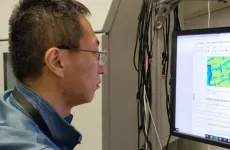(Press-News.org) Short and long term exposure to fine particulate matter (PM2.5) air pollution is linked to an increased risk of hospital admission for major heart and lung diseases, find two large US studies, published by The BMJ today.
Together, the results suggest that no safe threshold exists for heart and lung health.
According to the Global Burden of Disease study, exposure to PM2.5 accounts for an estimated 7.6% of total global mortality and 4.2% of global disability adjusted life years (a measure of years lived in good health).
In light of this extensive evidence, the World Health Organization (WHO) updated the air quality guidelines in 2021, recommending that an annual average PM2.5 levels should not exceed 5 μg/m3 and 24 hour average PM2.5 levels should not exceed 15 μg/m3 on more than 3-4 days each year.
In the first study, researchers linked average daily PM2.5 levels to residential zip codes for nearly 60 million US adults (84% white, 55% women) aged 65 and over from 2000 to 2016. They then used Medicare insurance data to track hospital admissions over an average of eight years.
After accounting for a range of economic, health and social factors, average PM2.5 exposure over three years was associated with increased risks of first hospital admissions for seven major types of cardiovascular disease - ischemic heart disease, cerebrovascular disease, heart failure, cardiomyopathy, arrhythmia, valvular heart disease, and thoracic and abdominal aortic aneurysms.
Compared with exposures of 5 μg/m3 or less (the WHO air quality guideline for annual PM2.5), exposures between 9 and 10 μg/m3, which encompassed the US national average of 9.7 μg/m3 during the study period, were associated with a 29% increased risk of hospital admission for cardiovascular disease.
On an absolute scale, the risk of hospital admission for cardiovascular disease increased from 2.59% with exposures of 5 μg/m3 or less to 3.35% at exposures between 9 and 10 μg/m3. “This means that if we were able to manage to reduce annual PM2.5 below 5 µg/m3, we could avoid 23% in hospital admissions for cardiovascular disease,” say the researchers.*
These cardiovascular effects persisted for at least three years after exposure to PM2.5, and susceptibility varied by age, education, access to healthcare services, and area deprivation level.
The researchers say their findings suggest that no safe threshold exists for the chronic effect of PM2.5 on overall cardiovascular health, and that substantial benefits could be attained through adherence to the WHO air quality guideline.
“On February 7, 2024, the US Environmental Protection Agency (EPA) updated the national air quality standard for annual PM2.5 level, setting a stricter limit at no more than 9 µg/m3. This is the first update since 2012. However, it is still considerably higher than the 5 µg/m3 set by WHO. Obviously, the newly published national standard was not sufficient for the protection of public health,” they add.*
In the second study, researchers used county-level daily PM2.5 concentrations and medical claims data to track hospital admissions and emergency department visits for natural causes, cardiovascular disease, and respiratory disease for 50 million US adults aged 18 and over from 2010 to 2016.
During the study period, more than 10 million hospital admissions and 24 million emergency department visits were recorded.
They found that short term exposure to PM2.5, even at concentrations below the new WHO air quality guideline limit, was statistically significantly associated with higher rates of hospital admissions for natural causes, cardiovascular disease and respiratory disease, as well as emergency department visits for respiratory disease.
For example, on days when daily PM2.5 levels were below the new WHO air quality guideline limit of 15 μg/m3, an increase of 10 μg/m3 in PM2.5 was associated with 1.87 extra hospital admissions per million adults aged 18 and over per day.
The researchers say their findings constitute an important contribution to the debate about the revision of air quality limits, guidelines, and standards.
Both research teams acknowledge several limitations such as possible misclassification of exposure and point out that other unmeasured factors may have affected their results. What’s more, the findings may not apply to individuals without medical insurance, children and adolescents, and those living outside the US.
However, taken together, these new results provide valuable reference for future national air pollution standards.
[Ends]
END
Air pollution linked to increased hospital admission for major heart and lung diseases
Two new studies suggest no safe air quality threshold exists for heart and lung health
2024-02-22
ELSE PRESS RELEASES FROM THIS DATE:
Children born in October least likely to get flu
2024-02-22
Children born in October are both more likely to be vaccinated against influenza and least likely to be diagnosed with influenza compared with children born in other months, finds a US study published by The BMJ today.
The results suggest that birth month is associated with both timing of flu vaccination and the likelihood of a flu diagnosis - and that October is the optimal time for young children to have a flu shot, in line with current recommendations.
Annual influenza vaccination is particularly important for young children, who are at higher risk of flu and severe ...
Uptake of HIV prevention medication doubles with mix of digital health interventions, study finds
2024-02-22
UNDER EMBARGO UNTIL 6:30 PM EST, Feb. 21, 2024
A UCLA Health-led study found a combination of interventions of one-on-one telehealth coaching, peer support forums, and automated text messages more than doubled the use of the HIV prevention strategy, called PrEP, among younger, at-risk Americans, a group that historically has had low use of the medication.
The randomized controlled trial results, published in the journal Lancet Digital Health, tested combinations of interventions to improve HIV prevention behaviors, including pre-exposure prophylaxis, or PrEP, among younger Americans who have historically ...
Seaports are hotspots of contagious cancer in mussels
2024-02-22
Seaports act as hubs for the global spread of MtrBTN2,1 a rare contagious cancer affecting mussels. In this disease, cancer cells can be transmitted, like parasites, from one mussel to another nearby. While, in nature, such contagion mainly occurs between mussels in the same bed, ports and maritime transport facilitate the spread of MtrBTN2 to other locations, through biofouling, whereby diseased mussels attach themselves to ship hulls. This finding, the fruit of research by a team led by scientists from the CNRS and the University of Montpellier,2 will be published in Proceedings of the Royal Society B ...
Cancer leaders pens "letter to the world" calling for urgent investment as global cancer cases predicted to rise
2024-02-22
In their ‘letter to the world’ they say that cancer is a ‘defining health issue of our time’ that requires a united and collective worldwide response on a par with Covid-19. The scientists argue that we’re at a ‘tipping point’ that could transform how we understand and treat cancer – but more support for life-saving research is required to beat the disease.
The letter is published as Cancer Research UK launched its More Research, Less Cancer campaign ...
Researchers use machine learning to predict how ingested drugs will interact with transport proteins
2024-02-22
Before orally administered drugs can make their way throughout the body, they must first bind to membrane proteins called drug transporters, which carry compounds across the intestinal tract and help them reach their intended targets. But because one drug can bind to several different drug transporters, they may struggle to get past this gut barrier, potentially leading to decreased drug absorption and efficacy. If another drug is added to the mix, interactions between the two compounds and their transporters can cause dangerous side effects.
Researchers ...
New detection method aims to warn of landslide tsunamis
2024-02-22
University of Alaska Fairbanks researchers have devised a way to remotely detect large landslides within minutes of occurrence and to quickly determine whether they are close to open water and present a tsunami hazard.
They write in a new paper that their method of determining a landslide’s location, volume and potential impact is rapid enough to support the National Oceanic and Atmospheric Administration’s goal of issuing a tsunami warning within 5 minutes of a landslide.
“The warming climate is causing glaciers to retreat, leaving behind valleys whose mountainsides and hillsides have lost their ...
Little groundwater recharge in ancient Mars aquifer, according to new models
2024-02-22
Mars was once a wet world. The geological record of the Red Planet shows evidence for water flowing on the surface – from river deltas to valleys carved by massive flash floods.
But a new study shows that no matter how much rainfall fell on the surface of ancient Mars, very little of it seeped into an aquifer in the planet’s southern highlands.
A graduate student at The University of Texas at Austin made the discovery by modeling groundwater recharge dynamics for the aquifer using a range of methods ...
Human-AI coworking
2024-02-21
Though artificial intelligence decreases human error in experimentation, human experts outperform AI when identifying causation or working with small data sets.
To capitalize on AI and researcher strengths, ORNL scientists, in collaboration with colleagues at National Cheng Kung University, Taiwan, and the University of Tennessee, Knoxville, developed a human-AI collaboration recommender system for improved experimentation performance.
During experiments, the system’s machine learning algorithms, described in npj Computational Materials, display preliminary ...
Vlasov and Bashir groups develop nanoscale device for brain chemistry analysis
2024-02-21
Longstanding challenges in biomedical research such as monitoring brain chemistry and tracking the spread of drugs through the body require much smaller and more precise sensors. A new nanoscale sensor that can monitor areas 1,000 times smaller than current technology and can track subtle changes in the chemical content of biological tissue with sub-second resolution, greatly outperforming standard technologies.
The device, developed by researchers at the University of Illinois Urbana-Champaign, is silicon-based and takes advantage of techniques developed for microelectronics manufacturing. ...
MD Anderson researchers receive over $25.5 million in CPRIT funding
2024-02-21
HOUSTON ― The University of Texas MD Anderson Cancer Center today was awarded 16 grants totaling over $25.5 million from the Cancer Prevention and Research Institute of Texas (CPRIT) in support of cancer screening, early detection and prevention programs, faculty recruitment, and groundbreaking cancer research across all areas of the institution.
“We are grateful for CPRIT’s continued funding of impactful cancer research and prevention programs at MD Anderson, which propels our efforts to deliver new breakthroughs and to advance our mission to end cancer,” said Peter WT Pisters, M.D., president of MD Anderson. “These efforts are pivotal to our institutional strategy ...
LAST 30 PRESS RELEASES:
Making lighter work of calculating fluid and heat flow
Normalizing blood sugar can halve heart attack risk
Lowering blood sugar cuts heart attack risk in people with prediabetes
Study links genetic variants to risk of blinding eye disease in premature infants
Non-opioid ‘pain sponge’ therapy halts cartilage degeneration and relieves chronic pain
AI can pick up cultural values by mimicking how kids learn
China’s ecological redlines offer fast track to 30 x 30 global conservation goal
Invisible indoor threats: emerging household contaminants and their growing risks to human health
Adding antibody treatment to chemo boosts outcomes for children with rare cancer
Germline pathogenic variants among women without a history of breast cancer
Tanning beds triple melanoma risk, potentially causing broad DNA damage
Unique bond identified as key to viral infection speed
Indoor tanning makes youthful skin much older on a genetic level
Mouse model sheds new light on the causes and potential solutions to human GI problems linked to muscular dystrophy
The Journal of Nuclear Medicine ahead-of-print tip sheet: December 12, 2025
Smarter tools for peering into the microscopic world
Applications open for funding to conduct research in the Kinsey Institute archives
Global measure underestimates the severity of food insecurity
Child survivors of critical illness are missing out on timely follow up care
Risk-based vs annual breast cancer screening / the WISDOM randomized clinical trial
University of Toronto launches Electric Vehicle Innovation Ontario to accelerate advanced EV technologies and build Canada’s innovation advantage
Early relapse predicts poor outcomes in aggressive blood cancer
American College of Lifestyle Medicine applauds two CMS models aligned with lifestyle medicine practice and reimbursement
Clinical trial finds cannabis use not a barrier to quitting nicotine vaping
Supplemental nutrition assistance program policies and food insecurity
Switching immune cells to “night mode” could limit damage after a heart attack, study suggests
URI-based Global RIghts Project report spotlights continued troubling trends in worldwide inhumane treatment
Neutrophils are less aggressive at night, explaining why nighttime heart attacks cause less damage than daytime events
Menopausal hormone therapy may not pose breast cancer risk for women with BRCA mutations
Mobile health tool may improve quality of life for adolescent and young adult breast cancer survivors
[Press-News.org] Air pollution linked to increased hospital admission for major heart and lung diseasesTwo new studies suggest no safe air quality threshold exists for heart and lung health




